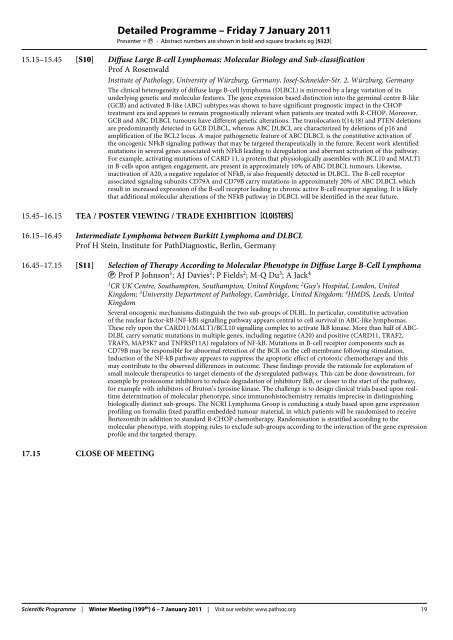Winter Meeting 2011 - The Pathological Society of Great Britain ...
Winter Meeting 2011 - The Pathological Society of Great Britain ...
Winter Meeting 2011 - The Pathological Society of Great Britain ...
Create successful ePaper yourself
Turn your PDF publications into a flip-book with our unique Google optimized e-Paper software.
15.15–15.45 [S10] Diffuse Large B-cell Lymphomas: Molecular Biology and Sub-classification<br />
Pr<strong>of</strong> A Rosenwald<br />
Institute <strong>of</strong> Pathology, University <strong>of</strong> Würzburg, Germany, Josef-Schneider-Str. 2, Würzburg, Germany<br />
<strong>The</strong> clinical heterogeneity <strong>of</strong> diffuse large B-cell lymphoma (DLBCL) is mirrored by a large variation <strong>of</strong> its<br />
underlying genetic and molecular features. <strong>The</strong> gene expression based distinction into the germinal centre B-like<br />
(GCB) and activated B-like (ABC) subtypes was shown to have significant prognostic impact in the CHOP<br />
treatment era and appears to remain prognostically relevant when patients are treated with R-CHOP. Moreover,<br />
GCB and ABC DLBCL tumours have different genetic alterations. <strong>The</strong> translocation t(14;18) and PTEN deletions<br />
are predominantly detected in GCB DLBCL, whereas ABC DLBCL are characterized by deletions <strong>of</strong> p16 and<br />
amplification <strong>of</strong> the BCL2 locus. A major pathogenetic feature <strong>of</strong> ABC DLBCL is the constitutive activation <strong>of</strong><br />
the oncogenic NFkB signaling pathway that may be targeted therapeutically in the future. Recent work identified<br />
mutations in several genes associated with NFkB leading to deregulation and aberrant activation <strong>of</strong> this pathway.<br />
For example, activating mutations <strong>of</strong> CARD 11, a protein that physiologically assembles with BCL10 and MALT1<br />
in B-cells upon antigen engagement, are present in approximately 10% <strong>of</strong> ABC DLBCL tumours. Likewise,<br />
inactivation <strong>of</strong> A20, a negative regulator <strong>of</strong> NFkB, is also frequently detected in DLBCL. <strong>The</strong> B-cell receptor<br />
associated signaling subunits CD79A and CD79B carry mutations in approximately 20% <strong>of</strong> ABC DLBCL which<br />
result in increased expression <strong>of</strong> the B-cell receptor leading to chronic active B-cell receptor signaling. It is likely<br />
that additional molecular alterations <strong>of</strong> the NFkB pathway in DLBCL will be identified in the near future.<br />
15.45–16.15 TEA / POSTER VIEWING / Trade Exhibition [Cloisters]<br />
16.15–16.45 Intermediate Lymphoma between Burkitt Lymphoma and DLBCL<br />
Pr<strong>of</strong> H Stein, Institute for PathDiagnostic, Berlin, Germany<br />
16.45–17.15 [S11] Selection <strong>of</strong> <strong>The</strong>rapy According to Molecular Phenotype in Diffuse Large B-Cell Lymphoma<br />
P Pr<strong>of</strong> P Johnson 1 ; AJ Davies 1 ; P Fields 2 ; M-Q Du 3 ; A Jack 4<br />
CR UK Centre, Southampton, Southampton, United Kingdom; 2 Guy’s Hospital, London, United<br />
Kingdom; 3 University Department <strong>of</strong> Pathology, Cambridge, United Kingdom; 4 HMDS, Leeds, United<br />
Kingdom<br />
Several oncogenic mechanisms distinguish the two sub-groups <strong>of</strong> DLBL. In particular, constitutive activation<br />
<strong>of</strong> the nuclear factor-kB (NF-kB) signalling pathway appears central to cell survival in ABC-like lymphomas.<br />
<strong>The</strong>se rely upon the CARD11/MALT1/BCL10 signalling complex to activate IkB kinase. More than half <strong>of</strong> ABC-<br />
DLBL carry somatic mutations in multiple genes, including negative (A20) and positive (CARD11, TRAF2,<br />
TRAF5, MAP3K7 and TNFRSF11A) regulators <strong>of</strong> NF-kB. Mutations in B-cell receptor components such as<br />
CD79B may be responsible for abnormal retention <strong>of</strong> the BCR on the cell membrane following stimulation.<br />
Induction <strong>of</strong> the NF-kB pathway appears to suppress the apoptotic effect <strong>of</strong> cytotoxic chemotherapy and this<br />
may contribute to the observed differences in outcome. <strong>The</strong>se findings provide the rationale for exploration <strong>of</strong><br />
small molecule therapeutics to target elements <strong>of</strong> the dysregulated pathways. This can be done downstream, for<br />
example by proteosome inhibitors to reduce degradation <strong>of</strong> inhibitory IkB, or closer to the start <strong>of</strong> the pathway,<br />
for example with inhibitors <strong>of</strong> Bruton’s tyrosine kinase. <strong>The</strong> challenge is to design clinical trials based upon realtime<br />
determination <strong>of</strong> molecular phenotype, since immunohistochemistry remains imprecise in distinguishing<br />
biologically distinct sub-groups. <strong>The</strong> NCRI Lymphoma Group is conducting a study based upon gene expression<br />
pr<strong>of</strong>iling on formalin fixed paraffin embedded tumour material, in which patients will be randomised to receive<br />
Bortezomib in addition to standard R-CHOP chemotherapy. Randomisation is stratified according to the<br />
molecular phenotype, with stopping rules to exclude sub-groups according to the interaction <strong>of</strong> the gene expression<br />
pr<strong>of</strong>ile and the targeted therapy.<br />
17.15 Close <strong>of</strong> <strong>Meeting</strong><br />
Detailed Programme – Friday 7 January <strong>2011</strong><br />
Presenter = P · Abstract numbers are shown in bold and square brackets eg [S123]<br />
Scientific Programme | <strong>Winter</strong> <strong>Meeting</strong> (199 th ) 6 – 7 January <strong>2011</strong> | Visit our website: www.pathsoc.org<br />
19













